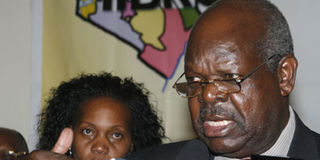Ligale team defends new electoral units

Chairman of the Interim Independent Boundaries Review Commission (IIBRC) Andrew Ligale (right) addresses a media briefing on January 18, 2010. Looking on is Commissioner Rozaah Akinyi. MPs from Coast and central Kenya accused the commission of “politically-driven bias” in the distribution of the new constituencies. Photo/FILE
Kenya's boundaries commission has defended the way it is distributing new constituencies, saying it was meant to correct the skewed creation of seats adopted by past governments.
Interim Independent Boundaries Review Commission chair Andrew Ligale, while explaining the mode they adopted in distributing the new 80 units, said a total of 27 constituencies among them President Kibaki’s Othaya posted population figures below their operating quota of 133,000 people.
These areas, he said, were favoured during the reign of retired President Daniel arap Moi. “There are areas which were favoured in the past and constituencies created without meeting the qualifying criteria that we have used. As a fact, there are 26 constituencies in the country whose populations are below the quota we are using,” he said.
Mr Ligale spoke in response to strong criticisms by MPs from Coast and central Kenya who accused his commission of “politically-driven bias” in the distribution of the new constituencies.
“We have not cooked any figures. We have our facts right. Because of the gerrymandering of the past, we have to make corrections and some provinces will end up with less numbers,” he said.
According to the IIBRC proposals, five counties stand to take the largest share of new constituencies if a controversial formula for creation of new electoral boundaries is gazetted.
A working document seen by Nation indicates that Nairobi county will have eight new constituencies followed by Nakuru county with five extra constituencies. Kakamega, Bungoma and Mandera counties will get four new constituencies.
The proposals have enraged some MPs who have threatened to go to court to block the gazettement of the final report by the IIBRC, which is expected to be ready in two weeks.
Mr Ligale, who was locked in a meeting with other commissioners finalising the report, said the MPs were free to go to court.
He said the population quota of 133,000 people was arrived at by dividing the total population in the country with the number of 290 constituencies as per the new Constitution.
In addition to other factors, he submitted that population was the most compelling factor in the creation of the new units. The calculations, he said, were based on the provinces which are being phased out.
Mr Ligale said that on the basis of population, there were nine constituencies in Coast, six each in Central and Eastern, four in Rift Valley and one in Western Province, which fall below the benchmark figure they had agreed on as the ideal number of people in a constituency.
On Thursday, MPs staged different press conferences to either trash or support the IIBRC proposals. After the morning news conference by MPs from Eastern and Central, another group of 19 MPs dismissed the assertions and expressed full confidence in the commission.
Led by assistant minister Aden Duale, the MPs who described themselves as “the face of Kenya” said they wanted those findings gazetted as they were.




